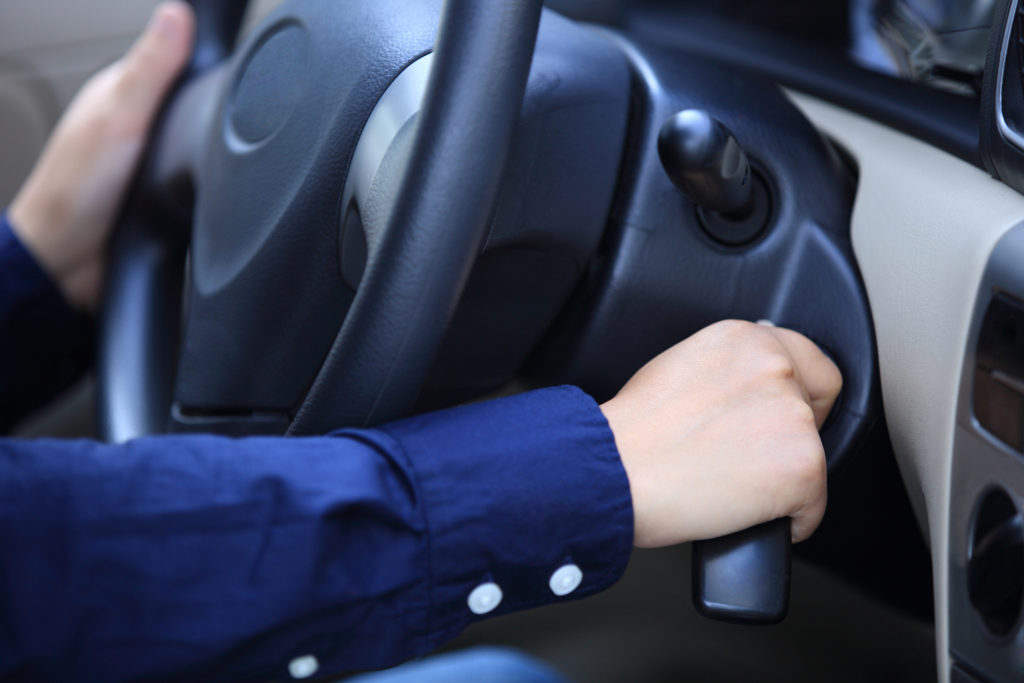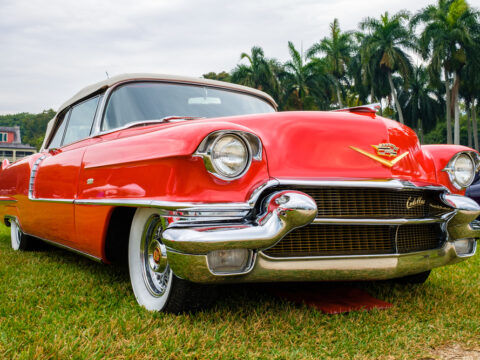Let’s be real—there’s something undeniably satisfying about revving your car’s engine and hearing its mechanical heart roar to life.
Beyond the intrinsic cool factor, there are situations in which it can be beneficial to rev your car’s engine. Here’s how to do it safely and to good effect.

“Revving” a car involves engaging the accelerator with the express purpose of increasing the engine’s latent speed. The term derives from the fact that manipulating the accelerator in this way forces the crankshaft to go through a great number of revolutions per minute (RPM).
Revving can be performed while the vehicle is either stationary or in motion. However, the former scenario is more common—most of the time, when you mash the gas pedal while driving, you’d just call it “speeding up.”
Contents
3 Reasons People Rev Their Cars
Contrary to popular belief, there are several reasons why a driver might see fit to rev their ride besides being desperate for attention. For instance:
- It helps distribute oil and other fluids. Revving helps circulate oil, gasoline, transmission fluid, and other vital substances on which vehicles rely, to operate correctly at peak capacity.
- It warms the car up. When it’s cold outside, getting the engine moving can help your vehicle build up thermal energy so you can use the heat-dependent features, like the windshield defroster.
- It allows you to reach high speeds faster. The higher the RPMs, the greater the momentum being created inside the engine. That momentum can immediately be converted to torque, the rotational force that powers the drivetrain, when the car is put in gear.
How to Rev a Car Properly (and Safely)
Now that you have a basic understanding of the when and why of engine revving, it’s time to learn a little about the how.
One quick note: revving your engine too hard or too often is a surefire way to shorten its lifespan. It’s therefore wise to refrain from doing so unless a particular maintenance task, repair project, or emergency demands it.
How to Rev a Car From the Engine Bay
Fire up your vehicle’s engine and pop the hood. Locate your air filter and follow the air intake tubing back toward the rear of the engine compartment where your intake manifold sits. There, you should find the throttle body, a large, round valve with a thumb lever attached to it.
Push down on this lever to open the throttle and rev the engine. Just avoid getting carried away, for safety’s sake—try to keep it below about 3,000rpm.
How to Rev a Car in Park
Start your engine, but don’t take your vehicle out of park. Wait 20-30 seconds for the oil to begin circulating and lubricate all of its core components. Once the engine is idling smoothly, step on the accelerator and apply pressure slowly and smoothly.
Make sure the needle on your tachometer stays below the redline or the end range of the gauge that indicates maximum sustainable engine speed.
How to Rev a Car in Neutral
With your car running, and your engine sufficiently lubricated, nudge your gear shift over to the neutral position, marked as “N” on the gear shift. Doing this will prevent the soon-to-be-very-active engine from generating torque and causing the wheels to turn. Press down gradually on the gas pedal until your tachometer displays the desired RPM. Keep it below the redline, and remember to shift out of neutral when finished.
How to Rev a Car While Driving
The safest, most responsible way to rev a car while driving is to simply shift over to neutral and carry out the procedure described above. If for some reason you feel the need to test your engine speed while you’re on the move, though, you also have the option of gunning it for a few seconds.
If you’re going to take this approach, find a straight, open stretch of well-maintained road and confirm that there are no other vehicles in the nearby vicinity.
You’ll also want to conduct your experiment in a spot without a posted speed limit, if possible. As you no doubt know, speeding is an offense punishable by stiff fines or jail time, and it could have far worse consequences if you’re not careful.

How Do You Rev an Automatic?
Raising your RPMs in an automatic couldn’t be simpler. Just put the vehicle in park or neutral and press down on the accelerator. The engine will surge, but the car won’t go anywhere as long as it’s in one of the two aforementioned gears.
As mentioned, you can also rev the engine of an automatic manually using the throttle body, which sits alongside the intake manifold inside the engine compartment. Technicians frequently employ this method when analyzing engine function.
How Do You Rev a Manual?
The key to revving the engine of a manual transmission vehicle is to engage the clutch, freeing up your transmission. Then hit the gas to boost your RPMs before shifting into the appropriate gear.
A crucial part of driving a stick shift is learning when and how to rev your engine correctly. Engine speed and ease of transmission are closely related. It’s such a useful skill that there’s even a special term for it: rev-matching.
Simple Tricks to Get a Car to Rev Higher
Looking for ways to get an already powerful motor purring like a wildcat in heat? Give one or more of these ingenious mechanical tweaks a shot:
- Switch to forged aluminum pistons to cut down on your reciprocating mass
- Increase your overall air intake by making use of variable lift valves
- Look for ways to decrease your compression ratio (i.e. installing low-compression pistons, shorter rods, and thicker head gaskets)
What Can Cause a Car Not to Rev?
If your car isn’t revving the way it’s supposed to, then it’s most likely experiencing technical difficulties.
Complications like low fuel pressure, a busted throttle position sensor, or a worn-out air flow regulator can all wreak havoc on your RPMs. And this is just a handful of potential explanations. There’s no way to figure out exactly where the hangup lies other than to take your vehicle in for a checkup or pull it apart yourself in an attempt to sniff out the malfunctioning part.
Unfortunately, both solutions will require some combination of time and money.
Can Revving the Engine Harm Your Car?
Under normal circumstances, revving the engine from time to time shouldn’t leave it any worse for wear. After all, car engines are designed to run at high speeds in short, periodic bursts and moderate speeds for long periods.
That said, if there are unaddressed mechanical issues affecting your engine or surrounding components, rampant revving has the potential to cause serious damage. For this reason, you should only do it when you’re certain that your vehicle is in good working order.
FAQ
Here are answers to some of the most commonly asked questions about revving and the effects it can have on your vehicle—and other drivers.
What is rev-matching?
Rev-matching is a form of active revving wherein the driver of a manual transmission vehicle modulates their RPMs to facilitate a smoother transition between gears.
Different gears have different transmission rates, and “matching” a particular rate by bringing your engine up to speed can make the resulting shift feel less clunky. When executed skillfully, rev-matching reduces the strain on both the engine and the transmission.
Should you rev a car when you’re jump-starting it?
In situations where your car’s battery is completely drained and you require a friendly jump just to get it started, revving your engine speed also speeds up the movement of the alternator, an electrical component that serves to charge the battery. As such, it can indeed help you get back up to full power faster.
Why does my car rattle when revved?
Rattling can occur for any number of reasons, some of which have nothing to do with what’s going on under the hood. Nine times out of ten, however, the culprit is a timing belt or chain tensioner that’s gone slack. Because of this loss of tension, the piece is moving around more than it should be, resulting in that annoying clattering sound you’ve been hearing.
Is revving your engine illegal?
There’s no law (at least in the U.S.) against revving your vehicle’s engine the way there are against peeling out or doing donuts, both of which can get you busted for reckless endangerment or “exhibition of speed.”
Even so, if your incessant revving is becoming a nuisance to other drivers, it’s conceivable that the police could pull you over for disturbing the peace. You don’t want to be that person.
Does revving the engine waste gas?
In a word, yes. The fact that you’re essentially throwing away fuel when you rev up is a pretty compelling reason to think twice before making it a habit, and it’s not the only one.
Putting the pedal to the metal when it’s not strictly necessary doesn’t just burn precious gas and create environmentally-unfriendly exhaust in the process. It also subjects your engine to unnecessary wear and tear, which is the last thing you want if you’re hoping to hold onto your vehicle for a while.














